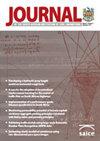天坑大小与钻孔危险分类的比较
IF 0.6
4区 工程技术
Q4 ENGINEERING, CIVIL
Journal of the South African Institution of Civil Engineering
Pub Date : 2023-06-27
DOI:10.17159/2309-8775/2023/v65n2a5
引用次数: 0
摘要
在南非的白云岩土地上,经常会出现凹陷。过去曾使用不同的方法对天坑发生的风险进行分类。本文将钻孔的固有危险分类(IHC)与实际发生的天坑进行了比较。国家天坑数据库和ENGEODE钻孔数据库均属于地球科学委员会(CGS),用于对钻孔的IHC和50米半径内的天坑大小进行比较。因此,数据库中的天坑被用于该比较,该比较具有位于离天坑50米以内的钻孔。分别确定并描述了四个地区,即远西兰德市、茨瓦内市和埃库胡莱尼市作为单独的地区,第四组为约翰内斯堡市和塞迪本市以及普马兰加省、西北省和北开普省。尽管低估了很高的比例(不同地区的比例从42%到59%不等),但钻孔和天坑的危险分类之间存在相对良好的IHC相关性(在56%到67%之间)。另一个问题是,在不同地区17%至29%的情况下,钻孔的IHC为1至4(低至中等风险),但仍形成了天坑。这些地区的问题更大,因为钻探的风险被低估了。目前对钻孔进行分类的方法尚未被证明能够百分之百准确地预测该地区的天坑大小,并且强调了钻孔分类时应考虑的几个因素。需要对钻孔的IHC与实际天坑之间的差异进行进一步的研究。本文章由计算机程序翻译,如有差异,请以英文原文为准。
Comparison of sinkhole size versus borehole hazard classification
Sinkholes are a common occurrence on dolomitic land in South Africa. Different methods have been used in the past to classify the risk of sinkhole occurrence. The inherent hazard classifications (IHC) of boreholes are compared in this article to actual sinkhole occurrences. The national sinkhole database and the ENGEODE database of boreholes, both belonging to the Council for Geoscience (CGS), were used for this comparison between the IHC of the borehole and the size of the sinkhole that occurred within a 50 m radius. Thus, the sinkholes in the database were used for this comparison that had a borehole located within 50 m from the sinkhole. Four regions were identified and described separately, namely the Far West Rand, the Tshwane and Ekurhuleni Municipalities as separate areas, and the fourth group as the Johannesburg and Sedibeng Municipalities and the Mpumalanga, North West and Northern Cape Provinces. Although a very high percentage has been underestimated (ranging from 42% to 59% for the different regions), there is a relatively good IHC correlation between the hazard classification of the boreholes and the sinkholes (between 56% to 67%). Another problem is that an IHC of 1 to 4 (low to medium risk) was assigned to the boreholes in 17% to 29% of the cases for the different areas, yet sinkholes still formed. These areas are more problematic, since the risk from the drilling has been underestimated. The current methodology to classify boreholes has not proved to be one hundred percent accurate to predict the size of the sinkhole for the area, and several factors have been highlighted that should be taken into account when boreholes are classified. Further research needs be carried out around the discrepancies between the IHC of boreholes compared to actual sinkholes.
求助全文
通过发布文献求助,成功后即可免费获取论文全文。
去求助
来源期刊
CiteScore
0.70
自引率
25.00%
发文量
19
审稿时长
>12 weeks
期刊介绍:
The Journal of the South African Institution of Civil Engineering publishes peer reviewed papers on all aspects of Civil Engineering relevant to Africa. It is an open access, ISI accredited journal, providing authoritative information not only on current developments, but also – through its back issues – giving access to data on established practices and the construction of existing infrastructure. It is published quarterly and is controlled by a Journal Editorial Panel.
The forerunner of the South African Institution of Civil Engineering was established in 1903 as a learned society aiming to develop technology and to share knowledge for the development of the day. The minutes of the proceedings of the then Cape Society of Civil Engineers mainly contained technical papers presented at the Society''s meetings. Since then, and throughout its long history, during which time it has undergone several name changes, the organisation has continued to publish technical papers in its monthly publication (magazine), until 1993 when it created a separate journal for the publication of technical papers.

 求助内容:
求助内容: 应助结果提醒方式:
应助结果提醒方式:


